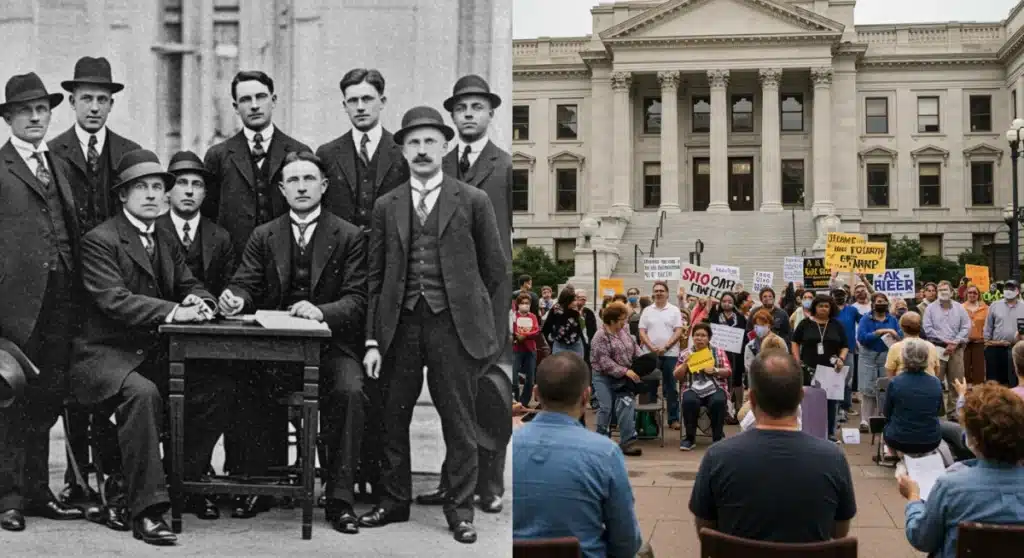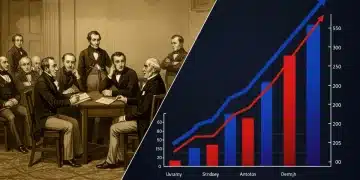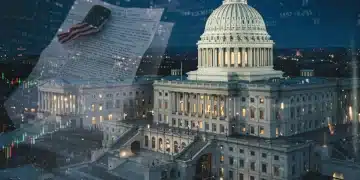Progressive Era Reforms: Impact on US Governance 2025

The Progressive Era’s reforms continue to profoundly influence US governance in 2025, shaping modern regulatory bodies, consumer protections, and the ongoing evolution of democratic processes and public accountability.
As of early 2025, the enduring legacy of The Progressive Era’s Reforms: How They Continue to Impact US Governance in 2025 remains a critical lens through which to understand America’s regulatory landscape, democratic structures, and social policies. Many foundational principles established over a century ago are still actively shaping current legislative debates and governmental operations. How do these historical movements resonate in today’s complex political environment?
Regulatory Frameworks and Consumer Protection in 2025
The Progressive Era, spanning roughly from the 1890s to the 1920s, marked a pivotal period of societal and governmental change in the United States. A central tenet of this era was the establishment of robust regulatory frameworks designed to curb corporate power and protect the public interest. Today, these historical precedents are more relevant than ever, as debates over corporate accountability and consumer rights dominate policy discussions.
Modern regulatory bodies, such as the Food and Drug Administration (FDA) and the Federal Trade Commission (FTC), trace their origins directly to Progressive Era demands for oversight. These agencies, empowered by legislation influenced by early 20th-century reformers, continue to adapt to new challenges, from digital privacy concerns to artificial intelligence ethics.
The Genesis of Modern Oversight
The push for federal regulation began with public outrage over unsafe products and monopolistic practices. Upton Sinclair’s The Jungle, for instance, exposed unsanitary conditions in the meatpacking industry, leading to the Meat Inspection Act and the Pure Food and Drug Act of 1906.
- Food and Drug Administration (FDA): Established to ensure the safety and efficacy of food, drugs, and cosmetics.
- Federal Trade Commission (FTC): Created to prevent unfair methods of competition and unfair or deceptive acts or practices.
- Interstate Commerce Commission (ICC): Though abolished, its principles laid the groundwork for regulating transportation and utilities.
These early legislative successes set a precedent for governmental intervention in the economy, a concept that continues to evolve. In 2025, new legislation is being considered to address data privacy and algorithmic bias, echoing the Progressive Era’s efforts to protect citizens from emerging corporate threats.
The ongoing discussions around regulating tech giants and their vast influence on information and commerce are direct descendants of the anti-monopoly sentiments of the Progressive Era. Policymakers are grappling with how to ensure fair competition and prevent the concentration of power, much like their predecessors did with industrial trusts.
Democratic Reforms and Electoral Integrity Today
The Progressive Era introduced significant reforms aimed at making government more accountable and responsive to its citizens. These changes fundamentally altered the American political landscape, and their impact is still felt in 2025 as the nation continues to refine its democratic processes.
Mechanisms like the initiative, referendum, and recall, which empower citizens to directly propose and vote on laws or remove elected officials, were hallmarks of the Progressive movement. While their application varies by state, these tools remain vital components of direct democracy.
Strengthening Citizen Participation
The fight for women’s suffrage, culminating in the 19th Amendment, was a monumental Progressive achievement. This expansion of voting rights laid the groundwork for subsequent movements advocating for broader political inclusion and equality.
- Initiative: Allows citizens to propose new laws or constitutional amendments.
- Referendum: Permits citizens to approve or reject laws passed by the legislature.
- Recall: Enables citizens to remove an elected official from office before their term expires.
In 2025, debates over electoral integrity, voter access, and campaign finance reform directly reflect these historical efforts. States are continuously evaluating their voting processes, from early voting options to voter ID laws, all under the umbrella of ensuring a fair and accessible democratic system, a core Progressive value.
The emphasis on transparent government and public accountability, championed by muckraking journalists and reformers of the era, continues to drive demands for open records and ethical conduct from public officials. Whistleblower protections and ethics commissions are modern manifestations of this enduring commitment.
Social Justice and Labor Rights: A Continuing Struggle
The Progressive Era was also characterized by a heightened awareness of social injustices and a concerted effort to improve working conditions and protect vulnerable populations. Many of the labor laws and social welfare programs in place today have roots in this period.
The establishment of child labor laws, minimum wage standards, and workplace safety regulations were direct outcomes of Progressive activism. These reforms sought to mitigate the harsh realities of industrialization and ensure a more equitable society.
Protecting the Vulnerable Workforce
Early labor movements, often supported by Progressive reformers, pushed for legislation that would provide basic protections for workers. This included limiting working hours, especially for women and children, and mandating safer environments.
- Child Labor Laws: Prohibited or restricted the employment of minors in hazardous occupations.
- Workplace Safety Standards: Mandated safer conditions and compensation for injuries.
- Minimum Wage: Although federal minimum wage came later, states began to adopt wage floors during this era.
Today, issues such as gig economy worker classification, unionization efforts, and debates over living wages are modern extensions of these historical struggles. The push for fair labor practices and robust social safety nets in 2025 directly mirrors the Progressive Era’s commitment to social justice and economic fairness.
The ongoing advocacy for universal healthcare and affordable housing also echoes the Progressive belief that government has a role in addressing societal inequities and ensuring a basic quality of life for all citizens. These discussions highlight the persistent relevance of Progressive ideals in contemporary policy debates.
Conservation and Environmental Stewardship
Another significant aspect of the Progressive Era was the birth of the modern conservation movement. Recognizing the rapid depletion of natural resources and the destruction of wilderness, reformers advocated for the protection and sustainable management of America’s natural heritage.
The establishment of national parks, national forests, and wildlife refuges under presidents like Theodore Roosevelt laid the foundation for federal environmental policy. This foresight continues to guide environmental protection efforts in 2025, as climate change and resource scarcity become increasingly pressing concerns.
Preserving Natural Resources for Future Generations
The idea that natural resources should be managed for the public good, rather than exploited for private gain, was a revolutionary concept at the time. This principle is fundamental to current environmental regulations and conservation strategies.
- National Park System: Protected vast areas of natural beauty and ecological significance.
- Forest Service: Managed national forests for sustainable timber production and recreation.
- Wildlife Refuges: Created to protect diverse species and their habitats.
In 2025, the challenges of climate change, biodiversity loss, and pollution are driving renewed focus on environmental stewardship. Modern legislation like the Clean Air Act and the Clean Water Act are direct descendants of the Progressive Era’s foundational conservation ethic, seeking to balance economic development with ecological preservation.
The ongoing debates about renewable energy, sustainable agriculture, and carbon emissions reflect the enduring Progressive insight that the health of the environment is inextricably linked to public welfare and long-term national prosperity. These discussions underscore the foresight of early conservationists.
Public Health Initiatives and Urban Planning
The rapid urbanization and industrialization of the late 19th and early 20th centuries created significant public health challenges. Progressive reformers responded by advocating for improved sanitation, public health infrastructure, and planned urban development.
These initiatives led to the creation of municipal health departments, modern sewage systems, and zoning laws, all designed to create healthier and more livable cities. The impact of these reforms is evident in the functioning of urban centers across the US in 2025.
Building Healthier and Safer Communities
Reforms in public health were often driven by scientific advancements and a growing understanding of disease transmission. This led to widespread public health campaigns and infrastructure projects that dramatically improved urban living conditions.
- Municipal Health Departments: Established to oversee sanitation, disease control, and public health education.
- Modern Sewage Systems: Replaced rudimentary systems, significantly reducing waterborne diseases.
- Zoning Laws: Separated residential, commercial, and industrial areas to improve living quality and safety.
In 2025, urban planning continues to evolve, addressing issues like affordable housing, public transportation, and green spaces. The foundational principles of systematic urban development and public health oversight, established during the Progressive Era, remain crucial for creating sustainable and equitable cities.
Current public health challenges, such as managing pandemics and addressing health disparities, draw upon the institutional frameworks and public awareness campaigns first developed by Progressive reformers. The emphasis on collective well-being and governmental responsibility for public health is a direct continuation of this historical movement.
Education Reform and Public Accountability
Education was another key area targeted by Progressive reformers, who believed that an educated populace was essential for a functioning democracy and a progressive society. Their efforts led to significant changes in public education, which continue to influence educational systems in 2025.
The push for compulsory education, standardized curricula, and professional teacher training aimed to create a more equitable and effective public school system. These reforms sought to prepare citizens for both civic engagement and the demands of an industrial economy.
Shaping Modern Educational Systems
Progressive educators like John Dewey advocated for a more child-centered approach to learning and practical skills development. This contrasted with earlier, more rigid educational models and laid the groundwork for modern pedagogical theories.
- Compulsory Education: Mandated school attendance for children up to a certain age.
- Standardized Curricula: Developed to ensure a consistent quality of education across schools.
- Professional Teacher Training: Elevated the status and effectiveness of the teaching profession.
In 2025, debates over educational funding, curriculum development, and school choice reflect the ongoing effort to provide quality education for all. The Progressive ideal of public education as a cornerstone of democracy and social mobility remains a guiding principle in these discussions.
The emphasis on accountability in education, through standardized testing and performance metrics, also has roots in the Progressive desire for efficient and effective public institutions. This continuous drive for improvement and equitable access to knowledge underscores the lasting impact of Progressive Era educational reforms.
| Key Aspect | Ongoing Impact in 2025 |
|---|---|
| Regulatory Frameworks | Foundational for modern agencies like FDA, FTC; influencing tech regulation. |
| Democratic Processes | Initiative, referendum, recall, and voting rights continue to shape elections. |
| Social & Labor Rights | Influencing minimum wage, workplace safety, and gig economy debates. |
| Environmental Stewardship | Basis for national parks, conservation efforts, and climate change policies. |
Frequently Asked Questions About Progressive Era Impact
Progressive Era reforms laid the groundwork for federal agencies like the FDA and FTC. These agencies continue to protect consumers from unsafe products and deceptive practices, now extending to digital goods and services, directly impacting how companies operate and how consumers are safeguarded today.
Yes, tools such as the initiative, referendum, and recall, popularized during the Progressive Era, are still actively used in many U.S. states. They allow citizens to directly influence legislation and hold elected officials accountable, demonstrating an enduring legacy of direct citizen participation in governance.
The Progressive Era significantly influenced modern labor laws by pushing for child labor prohibitions, workplace safety standards, and early minimum wage concepts. These historical efforts inform current debates on worker rights, unionization, and fair compensation, especially within emerging industries like the gig economy.
The Progressive Era established the foundational principles of conservation, leading to the creation of national parks and the U.S. Forest Service. This legacy continues to shape environmental policy, influencing modern climate change initiatives, resource management, and the ongoing protection of natural landscapes and biodiversity.
Progressive Era reforms introduced vital urban planning concepts, including modern sanitation systems, public health departments, and zoning laws. These innovations remain crucial for managing urban growth, ensuring public health, and creating sustainable, livable cities in 2025, addressing challenges like housing and infrastructure.
Looking Ahead
The continued resonance of Progressive Era reforms in 2025 underscores a fundamental truth about American governance: the pursuit of a more just, equitable, and accountable society is an ongoing process. As new challenges arise, from technological disruption to global climate crises, policymakers and citizens alike frequently look back to the Progressive playbook for inspiration. The debates over regulating artificial intelligence, ensuring data privacy, and addressing economic inequality are not merely contemporary issues but direct descendants of the Progressive spirit. What unfolds in the coming years will likely be a further evolution of these enduring principles, adapting them to the unique demands of the 21st century while retaining their core mission of public welfare and democratic integrity.





